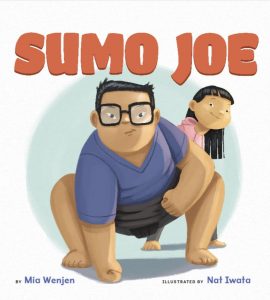This is Andrea Wang’s and my fourth installment of our Asian Culture Series. Today, we are talking oodles of noodles!
Asian Culture and KidLit series with Andrea Wang
September 2018: Cover Reveal! Andrea’s MAGIC RAMEN: The Story of Momofuku Ando
February 2019: Cover Reveal! Mia’s Sumo Joe
April 2019: Sumo, Ramen Noodles & Chinese Connection
June 2019: Tempura and Chankonabe (and how it’s related to our books!)
August 2019: Our Connection to Tokyo 2020 Olympics (Nissin Sports Advancement Foundation, Sumo for Girls)
October 2019: It’s a Small World: Nissin Connection
Today’s post is from Andrea!
Tempura and Chankonabe (and how it’s related to our books!)
Did you know that tempura consists of seafood and vegetables that are dipped in batter and then deep-fried. I’ve always thought of tempura as a quintessentially Japanese dish, so I was surprised to discover that it evolved from fried fish recipes that Portuguese missionaries and merchants brought to Nagasaki in the mid-16th century. Some believe that the word “tempura” is derived from the Latin “tempora” which referred to the season of Lent, when Portuguese Catholics abstained from red meat and ate fish or vegetables. Other possibilities are that “tempura” comes from the Portuguese words “tempero” (seasoning or condiment) or “temperar” (to season something).
By the 1950s, tempura was very popular in Japan. It’s a good thing it was, because without tempura, there may well have been no instant ramen! <Spoiler alert> In my picture book biography, MAGIC RAMEN: THE STORY OF MOMOFUKU ANDO, Ando has a breakthrough when he sees his wife Masako frying tempura for dinner. Up until then, he couldn’t figure out how to make ramen noodles that would cook quickly and easily by only adding hot water. The solution? Flash-frying the noodles. So, we have not only the Japanese to thank for instant ramen, but also the Chinese for the origins of ramen noodle soup, and the Portuguese for the tempura which gave Ando his “Yatta!” moment!
Shrimp tempura is a perennial favorite. Try making it Tokyo-style with this video:
Chankonabe is another popular Japanese dish, a one-pot stew that can be served hot-pot style at the table. Healthy and protein-rich, chankonabe is made with a dashi (bonito fish) or chicken broth soup base and a variety of meats, tofu, and vegetables – whatever the chef has on hand. A pot of this hearty stew can feed an entire family – or one sumo wrestler!
Sumo is a type of Japanese wrestling where two opponents try to force the other out of a circular ring or to touch the ground with any part of their bodies other than the bottoms of their feet. Typically, the greater a wrestler’s body mass, the harder they are to be shoved or thrown. In order to gain weight quickly, sumo wrestlers often eat massive quantities of chankonabe, accompanied by rice and beer to increase their calorie consumption even more.
Sumo is traditionally a male-only sport. In Mia Wenjen’s debut picture book, SUMO JOE, Joe’s younger sister Jo challenges this practice. Will Jo beat her older and bigger brother, or will her aikido skills make up for her size? Find out when SUMO JOE releases on June 11th! No matter the outcome, maybe both Joe and Jo can share a pot of delicious chankonabe together.
Video about how to make chankonabe:
Magic Raman: The Story of Momofuku Ando by Andrea Wang, illustrated by Kana Urbanowicz
Magic Ramen tells the secret story behind the invention of one of the world’s most popular instant ramen! [picture book biography, ages 4 and up]
Sumo Joe by Mia Wenjen, illustrated by Nat Iwata
If Sumo Joe and his friends (and sister) were to eat like sumo wrestlers, they would be having chankonabe for lunch! Sumo Joe releases in one week on June 11, 2019! [picture book, ages 4 and up]
Book Swag Giveaway!
We have some book swag to give away! Leave a comment to receive a surprise package!
To examine any book more closely at Amazon, please click on image of book.
As an Amazon Associate, I earn from qualifying purchases.
Follow PragmaticMom’s board Multicultural Books for Kids on Pinterest.
Follow PragmaticMom’s board Children’s Book Activities on Pinterest.
My books:
Amazon / Signed or Inscribed by Me
 Amazon / Signed or Inscribed by Me
Amazon / Signed or Inscribed by Me
Food for the Future: Sustainable Farms Around the World
- Junior Library Guild Gold selection
- Selected as one of 100 Outstanding Picture Books of 2023 by dPICTUS and featured at the Bologna Children’s Book Fair
- Starred review from School Library Journal
- Chicago Library’s Best of the Best
- 2023 INDIES Book of the Year Awards Finalist
- Green Earth Book Award longlist
- Imagination Soup’s 35 Best Nonfiction Books of 2023 for Kids
Amazon / Barefoot Books / Signed or Inscribed by Me



















I really loved Andrea Wang’s Magic Ramen and how it took a food that is so ubiquitous and gave us a charming story of perseverance and tireless dedication to rebuilding food security post-war, emergency. Sumo Joe sounds equally delightful. Love these connections to food and how you continue to give us the backstory of how things come to be. My father will be pleased with the mention of the origins of Tempura. He tells me that every time we eat it.
Congrats to you both!! I love MAGIC RAMEN :), and look forward to reading SUMO JOE, Mia!!
Interesting on how he solved the problem for ramen noodles. My daughters and I love asian food, these books would be a fun read.
I still have to read this book and will because I adore the premise.
I’m sure my students would love these books. I always try to include books from a variety of cultures in my classroom library.
Our family needs this book!
Thanks for sharing it and can’t wait to try to make chankonabe
Sounds yummy! Great way to have a book dinner tie-in.
Sounds interesting & looks delicious.
I’m late reading this post, but I want to comment that I think this is really important and so often goes unnoticed in the mainstream. My nieces’s father was born in the Philippines, but they did not grow up knowing much (anything really) about that culture. Now that one of the girls is trying learn and share facets of their heritage with her children I wish there were more examples in television and literature, so that it seemed natural and not “exotic”. What is this, the 1950’s? I’m hopeful that books like Sumo Joe will help move things forward.
These books all look adorable!
I would love to share with my class! I have been working to find more books about diversity!
These books look amazing!!! Can’t wait to read them and share with my students!